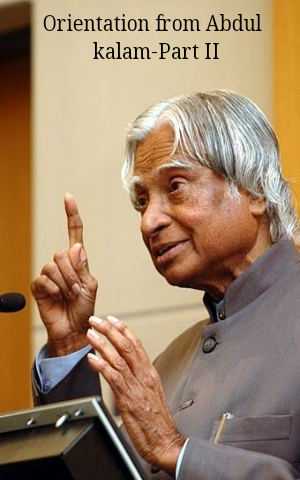Orientation from Abdul kalam-Part II
Orientation from Abdul kalam-Part II


Meanwhile, when I had finished my course work, I was assigned project to design a kow-level attack aircraft together with four other colleagues. I had taken up the responsibility of preparing and drawing the acrodynamic design. My team mates distributed among themselves the tasks of designing the propulsion, structure, control and instrumentation of the aireratft.
One day, my design teacher, Prof. Srinivasan then the Director of the MIT, reviewed my progress and declared it dismal and disappointing. I offered a dozen excuses for the delay, bat none of them impressed Prof. Srinivasan. I finally pleaded for a eth's time to complete the task. The Professor looked at me for Sme time and said "Laok, young man, today is Friday afternoon. I give Vea three days tìme. Ifby Monday moming I don't get the configuration drawing. your scholarship will be stopped." I was dumbstruck, The scholarship was my lhifeline and I would be quite helpless if it was withdrawn I could see no other way out but to finish the task as I had been instructed That night, I remained at the drawing board, skipping dinner Next movning, I took only an hour's break to freshen up and eat a littie food. On Sunday coming,
I was very near completion when suddenly I felt someone else's presence in the room. Prof. Srinivasan was watching me from a distance. Coming straight from the gymkhana, be was still in his tennis outfit and had dropped in to see my progress. After examining my work, Prof. Srinivasan hugged me affectionately and patted my back in appreciation. He said, "I knew I was putting you under stress and asking you to meet an impossible deadline. I never expected you to perform so well."
During the rest of the period of the project, I participated in an essay competition organized by the MIT Tamil Sangam (Literary Society). Tamil is my mother tongue am proud of its origins, which have been traced back to Sage Agastya in the pre-Ramayana period; its literature dates back to the fifth century BC. It is said to be a language molded by lawyers and grammarians and is internationally acclaimed for its clear-cut logic. I was very enthusiastic about ensuring that science did not remain outside the purview of this wonderful language. I wrote an article entitled "Let Us Make Our Own Aircraft" in Tamil. The article evoked much interest and I won the competition, taking the first prize from 'Devan', the editor of the popular Tamil weekly, Ananda Vikatan.
My most touching memory of MIT is related to Prof. Sponder. We were posing for a group photograph as part of a farewell ritual. All the graduating students had lined up in three rows with the professors seated in the front. Suddenly, Prof. Sponder got up and looked for me, I was standing in the third row. "Come and sit with me in the front," he said. I was taken aback by Prof Sponder's invitation. "You are my best student and hard work will help you bring a great name for your teachers in future." Embarrassed by the praise but honoured by the recognition, I sat with Prof. Sponder for the photograph. "Let God be your hope, your stay, your guide and provide the lantern for your feet in your jourmey into the future," said the introverted genius, bidding me adieu.
From MIT, I went to Hindustan Aeronautics Limited (HAL) at Bangalore as a trainee. There I worked on engine overhauling as part of team. Hands-on work on aircraft engine overhauling was very educative. When a principle learnt in the classroom is borne out by practical experience, it creates a strange sense of excitement-akin to unexpectedly running into an old friend among a crowd of strangers. At HAL, I worked on the overhauling of both piston and turbine engines. The hazy concepts of gas dynamics and diffusion processes in the working principle of after burning came into sharper focus in my mind. I was also trained in radial engine-cum-drum operations.
I learned how to check a crankshaft for wear and tear, and a connecting rod and crankshaft for twist. I did calibrations of a fixed- pitch fan fitted to a super-charged engine. I opened up pressure and acceleration-cum-speed control systems, and air starter supply systems of turbo-engines. Getting to understand feathering, un-feathering and reversing of propeller engines was very interesting. The demonstration of the delicate art of beta (blade angle control) by HAL technicians still lingers in my memory. They had neither studied in major universities, nor were they merely implementing what their engineer-in-charge was suggesting. They had been working hands-on for years and this had given them something like an intuitive feel for the work.
Two alternative opportunities for employment, both close to my long- standing dream of flying, presented themselves before me when I came out of HAL as a graduate aeronautical engineer. One was a career in the Air Force and another was a job at the Directorate of Technical Development and Production, DTD&P(Air), at the Ministry of Defence. I applied for both. The interview calls arrived from both the places almost simultaneously. I was asked to reach Dehra Dun by the Air Force recruitment authorities and Delhi by DTD&P(Air). The boy from the Coromandel Coast took a train to the North of India. My destination was more than 2000 km away, and was to be my first encounter with the vastness of my motherland.





























